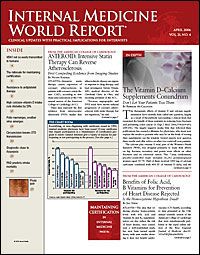Publication
Article
Internal Medicine World Report
ASTEROID: Intensive Statin Therapy Can Reverse Atherosclerosis
Author(s):
First Compelling Evidence from Imaging Studies
Atlanta?Intensive statin therapy causes regression of coronary atherosclerosis in patients with coronary artery disease (CAD), according to new study data announced at the 55th annual session of the American College of Cardiology (ACC).
These data represent the first evidence from intravascular ultra?sound (IVUS) studies that atherosclerotic disease can regress in re?sponse to drug therapy, said lead investigator Steven Nissen, MD, medical director of the Cleveland Clinic in Ohio, and incoming president of the ACC.
"Previous angiographic and IVUS trials have shown reduced progression of coronary atherosclerosis with statin therapy, but not regression," he said.
Based on the results of ASTEROID (A Study to Evaluate the Effect of Rosu?vastatin on Intravascular Ultra?sound-Derived Coronary Atheroma Burden), Dr Nissen believes that "maximally intensive statin therapy seems warranted in high-risk patients with CAD."
Final IVUS data were available for 349 patients enrolled in ASTEROID. All patients had CAD, defined as >20% stenosis in any major coronary artery, and all were treated with rosuvastatin (Crestor), 40 mg/day. Their mean low-density lipoprotein cholesterol (LDL-C) level of 130.4 mg/dL at baseline was reduced by 53% at the end of 24 months of treatment. In addition, their high-density lipoprotein cholesterol level increased by 14.7% from baseline, from 43.1 mg/dL to 49.0 mg/dL.
The final LDL-C concentration of 60.8 mg/dL was the lowest ever achieved in a major clinical trial studying the effect of statin therapy on atherosclerosis, said Dr Nissen.
Atheroma volume decreased by a mean of 0.98% and a median of 0.79% from baseline (P <.001), and 63.6% of the study group experienced some atherosclerosis regression.
Atheroma volume in the most diseased 10-mm artery segments regressed by a mean of 6.1 mm3 and a median of 5.6 mm3 (P <.001). "This change represents a median reduction of 9.1% in atheroma volume in the 10-mm segment with the greatest disease severity," according to Dr Nissen.
"We know that plaque begins to form often in the 20s and 30s," he said. "Our average patient was 58 years of age, so think of this as partially reversing the disease that's been accumulating for 3 decades."
Although extrapolating reductions in atheroma volume to reductions in clinical events is speculative, he said that "we're looking at the disease itself with IVUS. I expect that we'll find that this signal is confirmed with morbidity and mortality benefit."
Despite the success of intensive therapy to reduce LDL-C levels to well below those recommended in current guidelines for patients with CAD, "it is by no means sufficient to alter guidelines, and individual physicians will make up their own minds about how compelling an argument can be made for taking LDL lower," Dr Nissen added. "I wonder if the best standard is not to use target cholesterol levels but to say: let's get our patients with ?coronary disease as low an LDL cholesterol as achievable without creating safety problems."
The results of ASTEROID have also been published simultaneously in the Journal of the American Medical Associa?tion (2006;295:1556-1565). The article was accompanied by an ?editorial (2006;295:1583-1584) written by Roger Blumenthal, MD, and Navin Kapur, MD, of Johns Hopkins University in Baltimore, who remind physicians that aggressive LDL-C?lowering therapy has already been shown to reduce clinical end points in randomized controlled trials.





